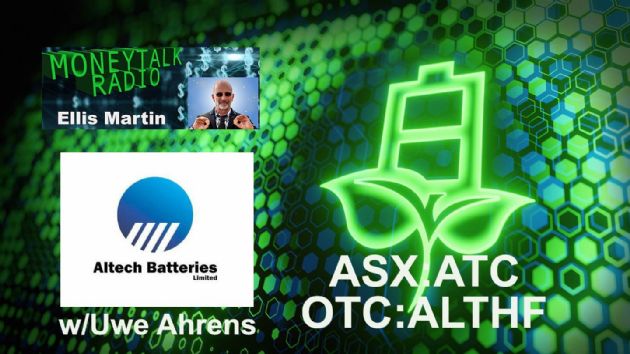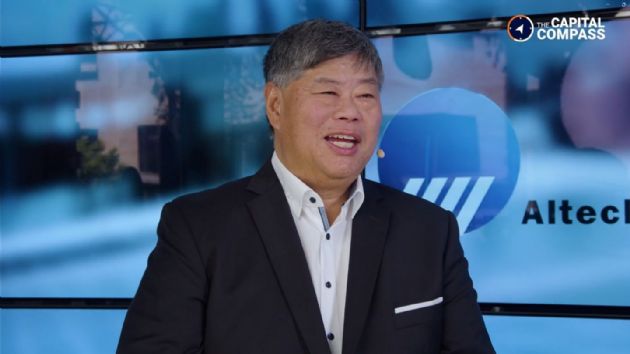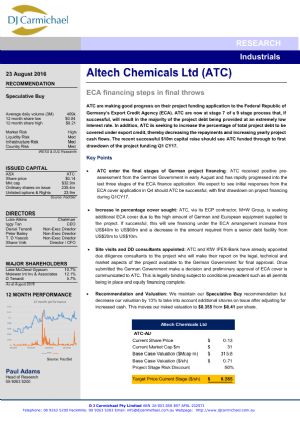ALTECH - SPHERICAL COATED SILICON (5% ADDITION) ACHIEVES 88.5% RETENTION AFTER 500 CYCLES
Perth, Oct 9, 2025 AEST (ABN Newswire) - Altech Batteries Limited ( ASX:ATC) (
ASX:ATC) ( A3Y:FRA) (
A3Y:FRA) ( ALTHF:OTCMKTS) is pleased to announce a major advancement in its Silumina Anodes(TM) Project, achieving the strongest battery cycling performance recorded to date for its proprietary alumina-coated spherical silicon anode material. The latest results demonstrate 88.5% capacity retention after 500 charge-discharge cycles for a 5% addition of Silumina Anodes(TM) to a graphite anode, with a repeated test confirming greater than 88.0% retention at the same interval-validating both the consistency and reproducibility of the Company's process.
ALTHF:OTCMKTS) is pleased to announce a major advancement in its Silumina Anodes(TM) Project, achieving the strongest battery cycling performance recorded to date for its proprietary alumina-coated spherical silicon anode material. The latest results demonstrate 88.5% capacity retention after 500 charge-discharge cycles for a 5% addition of Silumina Anodes(TM) to a graphite anode, with a repeated test confirming greater than 88.0% retention at the same interval-validating both the consistency and reproducibility of the Company's process.
Highlights
- 5% Silumina Anodes(TM)addition achieved 88.5% capacity retention after 500 cycles
- Repeated testing confirmed >88.0% retention, proving reproducibility and process stability
- Silicon stores ten times more lithium than graphite, boosting anode energy density
- Spherical alumina-coated silicon reduces swelling induced electrode degradation
- Silumina anodes deliver 500 mAh/g initial capacity, >40% higher than that of commercial graphite anode
- After 500 cycles, capacity remains 420 mAh/g - greater than 60% of graphite-only cells
- Higher anode capacity enables longer EV range, lighter packs, and improved efficiency
- Saxony pilot plant producing consistent high-quality material, confirming readiness for commercial scale-up
Silicon is being increasingly adopted in the battery industry because it can store nearly ten times more lithium ions per gram than graphite, offering a pathway to dramatically higher energy densities. However, this benefit has historically come at a cost: when silicon absorbs lithium during charging, it can expand by up to 300%, causing mechanical stress, particle fracture, and rapid capacity loss.
Altech's achievement breaks this paradigm. The Company's alumina-coated spherical silicon particles not only deliver the inherent energy-density advantage of silicon but also sustain exceptional stability over extended cycling. Altech's technology has effectively neutralised the problem of volumetric expansion and preserved electrical integrity throughout repeated charge-discharge cycles. The result is a material that combines higher capacity and longer life-a key milestone in the global race to commercialise nextgeneration lithium-ion anodes.
BENEFITS EXPLAINED
In conventional lithium-ion batteries, the anode is composed almost entirely of graphite. While graphite has been a proven and reliable material for decades, its specific capacity is inherently limited to about 350 mAh/g during initial formation cycles. Over time, as the battery is cycled repeatedly, minor structural fatigue and SEI (solid electrolyte interphase) thickening gradually reduce the number of active lithium sites.
According to Altech's test results, the practical capacity of a graphite-only anode at the same test condition declines to 230-250 mAh/g after 500 cycles. This decline constrains the total energy that can be stored in a cell, meaning that improvements in battery range and energy density must come from other components such as the cathode, packaging, or cell design - each of which offers diminishing returns.
By contrast, Altech's proprietary Silumina Anodes(TM) technology introduces a carefully optimised 5 per cent silicon addition to the graphite structure. Because silicon can host nearly ten times more lithium ions per gram than graphite, even a modest percentage dramatically increases the anode's overall capacity. In testing, cells containing this 5 per cent spherical alumina-coated silicon blend recorded an initial capacity of 500 mAh/g, representing >40 per cent improvement over standard graphite. More importantly, this enhanced performance was largely retained over long-term cycling: after 500 charge-discharge cycles, capacity remained between 420 mAh/g - a level equivalent to the starting capacity of many currentgeneration EV batteries.
The implications of this step-change are profound for the design of next-generation lithium-ion cells. With higher capacity available in the anode, cell designers can either increase total energy density or reduce battery mass and volume while maintaining range. For electric-vehicle applications, without change in battery size, this translates directly into longer driving range per charge, or smaller and lighter battery packs, and improved overall vehicle efficiency. At a system level, higher anode capacity also improves volumetric energy density - a critical parameter for portable electronics, drones, and aerospace systems where every cubic centimetre matters.
A 40-50 per cent improvement at the anode typically equates to a 20-25 per cent gain in total cell energy, depending on cathode pairing. This allows battery manufacturers to deliver more watt-hours per cell, reduce the number of cells per module, and simplify battery-management systems. In stationary or grid-storage markets, the benefit is lower footprint and reduced balance-of-plant costs, enhancing competitiveness against alternative chemistries.
For the broader battery industry, these results demonstrate a practical pathway to incorporate silicon - long viewed as the "holy grail" of anode materials - without compromising durability or safety. Until now, most silicon-enhanced anodes have suffered from rapid capacity fade or expansion-induced electrode failure, confining their use to small-format cells or niche applications. Altech's success in maintaining graphite-like retention while doubling the specific capacity per gram opens the door for mainstream automotive adoption.
HOW SILUMINA IS MADE
Altech's spherisation process transforms irregular silicon particles into perfectly rounded, alumina-coated spheres that integrate seamlessly within graphite anodes. The process begins with submicron silicon powders that are uniformly coated with a nanolayer of high-purity alumina, buffering against volume expansion during lithiation. These coated particles are then spherified through a precision-controlled thermal and mechanical process that rounds their geometry (See Figure 1*). When blended into the graphite matrix, the spherical Silumina particles naturally occupy microscopic voids, where they can expand and contract freely during cycling without damaging the surrounding structure (See Figure 2*). This optimised configuration mitigates mechanical stress, maintains electrode integrity, and enhances electrical connectivity. With only a 5% addition, the design achieves >40% capacity boost while preserving exceptional cycle stability over extended use.
SAXONY PILOT PLANT IN OPERATION
Altech is in a race to bring its patented Silumina Anodes(TM) technology to market. To accelerate development, the Company established a fully equipped pilot plant adjacent to the proposed commercial site at Dock 3 in Saxony, Germany, to support product qualification and process optimisation. The facility is now operating smoothly, producing multiple batches of high-quality alumina-coated silicon particles that demonstrate excellent consistency with results from Altech's Perth laboratory. Several silicon sources are being trialled to assess performance, purity, and cost efficiency, ensuring robust supply-chain flexibility.
SUMMARY
In summary, moving from a 230-250 mAh/g graphite-only anode after 500 cycles to a 420 mAh/g Silumina Anodes(TM)-enhanced anode represents not just an incremental improvement but a fundamental leap in energy storage capability. It allows manufacturers to extract more power, range, and lifespan from each unit of cell volume - enabling longer-range vehicles, smaller and lighter packs, lower system costs, and reduced environmental impact. For an industry seeking to balance energy density with sustainability and safety, Altech's breakthrough provides a compelling and scalable solution poised to redefine the performance standards of lithium-ion technology.
Altech Managing Director Iggy Tan said:
"These latest results mark a genuine breakthrough for the battery industry. Achieving 88.5% retention at 500 cycles with a 5% silicon addition confirms the stability of our Silumina Anodes(TM) process. Our team in Saxony continues to deliver highly consistent results, validating the technology and scaling methods.
Altech's breakthrough positions us at the forefront of next-generation anode materials, unlocking longerlasting, higher-capacity lithium-ion batteries."
*To view tables and figures, please visit:
https://abnnewswire.net/lnk/1S9132NJ
About Altech Batteries Ltd
 Altech Batteries Limited (ASX:ATC) (FRA:A3Y) is a specialty battery technology company that has a joint venture agreement with world leading German battery institute Fraunhofer IKTS ("Fraunhofer") to commercialise the revolutionary CERENERGY(R) Sodium Alumina Solid State (SAS) Battery. CERENERGY(R) batteries are the game-changing alternative to lithium-ion batteries. CERENERGY(R) batteries are fire and explosion-proof; have a life span of more than 15 years and operate in extreme cold and desert climates. The battery technology uses table salt and is lithium-free; cobalt-free; graphite-free; and copper-free, eliminating exposure to critical metal price rises and supply chain concerns.
Altech Batteries Limited (ASX:ATC) (FRA:A3Y) is a specialty battery technology company that has a joint venture agreement with world leading German battery institute Fraunhofer IKTS ("Fraunhofer") to commercialise the revolutionary CERENERGY(R) Sodium Alumina Solid State (SAS) Battery. CERENERGY(R) batteries are the game-changing alternative to lithium-ion batteries. CERENERGY(R) batteries are fire and explosion-proof; have a life span of more than 15 years and operate in extreme cold and desert climates. The battery technology uses table salt and is lithium-free; cobalt-free; graphite-free; and copper-free, eliminating exposure to critical metal price rises and supply chain concerns.
The joint venture is commercialising its CERENERGY(R) battery, with plans to construct a 100MWh production facility on Altech's land in Saxony, Germany. The facility intends to produce CERENERGY(R) battery modules to provide grid storage solutions to the market.



![abnnewswire.com]()
Related Companies
Social Media
Share this Article
 ASX:ATC) (
ASX:ATC) ( A3Y:FRA) (
A3Y:FRA) ( ALTHF:OTCMKTS) is pleased to announce a major advancement in its Silumina Anodes(TM) Project, achieving the strongest battery cycling performance recorded to date for its proprietary alumina-coated spherical silicon anode material. The latest results demonstrate 88.5% capacity retention after 500 charge-discharge cycles for a 5% addition of Silumina Anodes(TM) to a graphite anode, with a repeated test confirming greater than 88.0% retention at the same interval-validating both the consistency and reproducibility of the Company's process.
ALTHF:OTCMKTS) is pleased to announce a major advancement in its Silumina Anodes(TM) Project, achieving the strongest battery cycling performance recorded to date for its proprietary alumina-coated spherical silicon anode material. The latest results demonstrate 88.5% capacity retention after 500 charge-discharge cycles for a 5% addition of Silumina Anodes(TM) to a graphite anode, with a repeated test confirming greater than 88.0% retention at the same interval-validating both the consistency and reproducibility of the Company's process.  Altech Batteries Limited (ASX:ATC) (FRA:A3Y) is a specialty battery technology company that has a joint venture agreement with world leading German battery institute Fraunhofer IKTS ("Fraunhofer") to commercialise the revolutionary CERENERGY(R) Sodium Alumina Solid State (SAS) Battery. CERENERGY(R) batteries are the game-changing alternative to lithium-ion batteries. CERENERGY(R) batteries are fire and explosion-proof; have a life span of more than 15 years and operate in extreme cold and desert climates. The battery technology uses table salt and is lithium-free; cobalt-free; graphite-free; and copper-free, eliminating exposure to critical metal price rises and supply chain concerns.
Altech Batteries Limited (ASX:ATC) (FRA:A3Y) is a specialty battery technology company that has a joint venture agreement with world leading German battery institute Fraunhofer IKTS ("Fraunhofer") to commercialise the revolutionary CERENERGY(R) Sodium Alumina Solid State (SAS) Battery. CERENERGY(R) batteries are the game-changing alternative to lithium-ion batteries. CERENERGY(R) batteries are fire and explosion-proof; have a life span of more than 15 years and operate in extreme cold and desert climates. The battery technology uses table salt and is lithium-free; cobalt-free; graphite-free; and copper-free, eliminating exposure to critical metal price rises and supply chain concerns. 













